Growing bentgrass in tropical heat
With some notes about bentgrass clipping production at high temperatures
Bentgrass grows more—or at least it produces more clippings for a while—when temperatures are higher than optimum for net photosynthesis. This means that you’ll typically see more clippings when the temperature is above the optimum for cool-season grass, even though the growth potential (GP) goes down at those high temperatures.
This is a topic that I’ve been asked about many times, and that I thought I’d written about somewhere already. But not finding that explanation, I decided to explain this as a blog post.
The GP equation1 converts the temperature to a number between 0 and 1, based on how close the actual temperature is to the optimum temperature. If the temperature is close to the optimum temperature, then the GP will be close to 1. If the temperature is far from the optimum temperature, the GP will be close to 0.
To understand why the clipping amounts don’t match the GP, I find it useful to think of the optimum temperature in the GP equation not as the optimum temperature for growth, but as the optimum temperature for net photosynthesis. For much of the year, the growth and the net photosynthesis and the GP are going to be aligned. But in the case of high temperatures and cool-season grass, they are not, and to make sense of what is happening one can think of the optimum temperature for net photosynthesis.
More clippings at high temperatures
This is a year of temperatures at Hiroshima in western Japan.
When those temperatures are converted to a cool-season grass (C3) growth potential (GP), there are peaks in GP during spring and autumn. In winter the temperatures are too cold, and the hottest days of summer are too hot.
One might expect that bentgrass growth would follow a similar curve, with little growth in winter, peak growth in spring and autumn, and a dip in the high temperatures of summer.
But that is not what happens.
This chart2 has clipping volume data for a couple courses with bentgrass greens in Japan at a similar latitude (and temperature) as Hiroshima. It’s obvious that the clipping volume is highest in the summer. There’s no dip like one sees with the GP calculation.
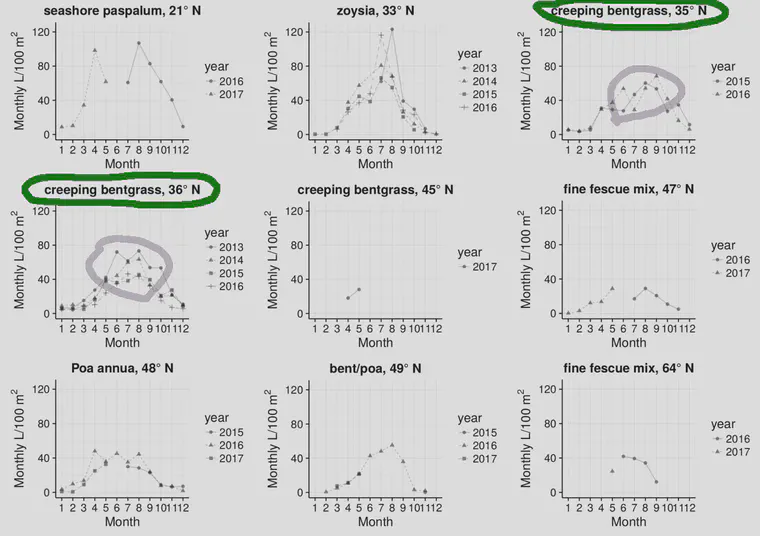
The clipping volume is at the highest during the hottest months of summer. But the grass is dying. It is using up the carbohydrates stored from times of high GP (and consequently high potential net photosynthesis), and if the high temperature would persist, the grass would die.
I find it useful to consider, for a moment, the situation of bentgrass in tropical temperatures.
Bentgrass in Bangkok
Did you know that bentgrass can grow in Bangkok? I grew creeping bentgrass and other cool-season grasses from seed.
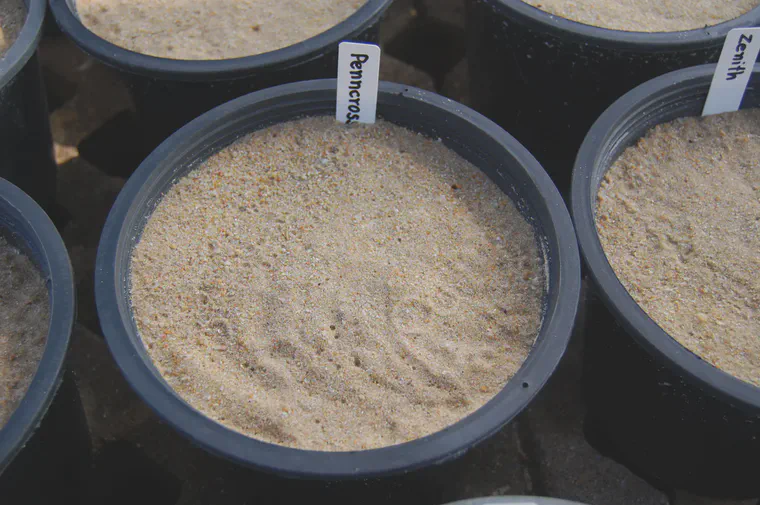
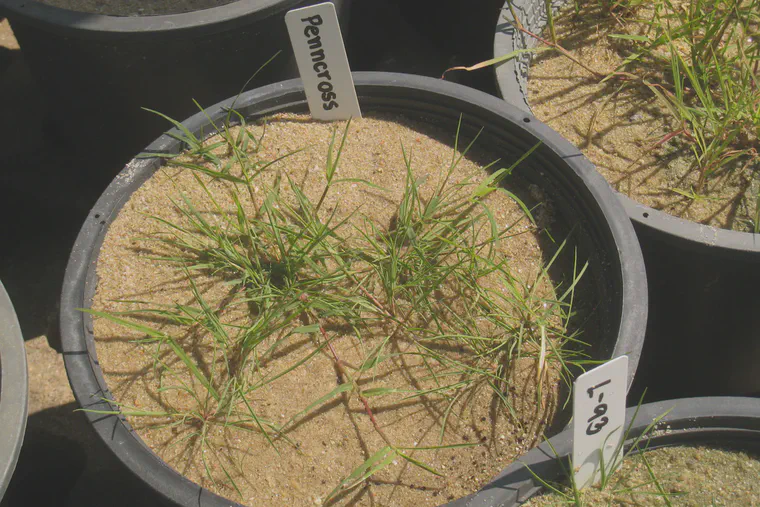
The grasses germinate and grow. But one can’t really mow them, because the plants grow up to a moderate height and then stop growing. If one would mow them, they’d die faster.
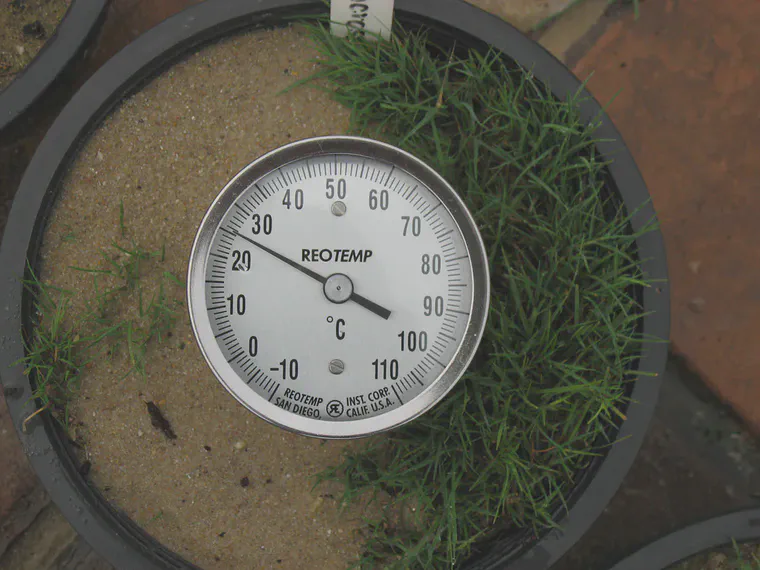
Cool season grasses can’t persist in these temperatures, with mowing, because they have a negative carbon balance. At tropical temperatures, the carbon lost through respiration is greater than the carbon stored through photosynthesis.
Adding more N fertilizer, or mowing the grass, is bound to kill the grass even faster.
Tropical temperatures and bentgrass in Japan
Golf courses in Japan typically have creeping bentgrass putting greens.
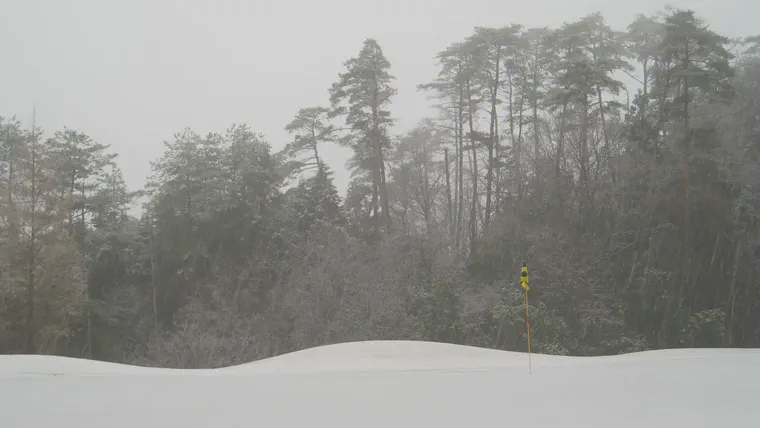
During much of the year, the bentgrass has a high growth potential. But in the hottest days of summer, the temperature is hotter than it is in a tropical location.
In 2020, there were 17 days at Hiroshima, about 2 weeks, with a mean temperature higher than the hottest day of the year in Singapore (at the Changi station). And there were 72 days in Hiroshima, about two months, with what I’d call tropical temperatures. That is, there were 72 days when the mean temperature at Hiroshima was equal to or higher than the lowest mean daily temperature of the year at Singapore.
So what’s going on?
And why can there be bentgrass greens in Japan but not in Singapore or Bangkok? And why is the clipping volume so high when the temperatures are way too high for bentgrass?
It’s simply this. If you go into the summer in Hiroshima with healthy bentgrass, it’s going to die a little every day in the high temperatures, growing too fast, burning up stored carbohydrates, and producing a lot of clippings.
But the summer in Hiroshima comes to an end, net photosynthesis turns positive again, and the grass can recover. In Bangkok and Singapore, the summer never comes to an end. When the summer heat goes on for too long, the cool-season grass doesn’t persist.
The growth potential equation is
You can find this chart with more information in Appendix B of my clipping volume book. ↩︎